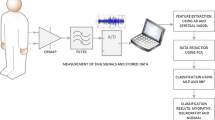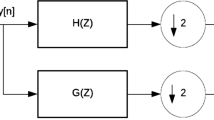Abstract
In this study the performance of support vector machine (SVM)and back-propagation neural network were applied to analyze the classification of the electromyogram (EMG) signals obtained from normal, neuropathy and myopathy subjects. By using autoregressive (AR) modeling, AR coefficients were obtained from EMG signals. Moreover, the support vector machine and artificial neural network (ANN) were used as base classifiers. The AR coefficients were benefited as inputs for SVM and ANN. Besides, these coefficients were tested both in ANN and SVM. The results show that SVM has high anticipation level in the diagnosis of neuromuscular disorders. It is proved that its test performance is high compared with ANN.
Similar content being viewed by others
References
Basmajian, J., and De Luca, C. J., Muscles Alive, Williams & Wilkins, Baltimore, 1985.
Deluca, C. J., Towards Understanding the EMG Signal Ch 3 of Muscles Alive, fourth edition, Williams & Wilkonson, Bultimore, 1978.
Stalberg, E., Andreassen, S., Falck, B., Lang, H., Rosenfalck, A., and Trojaborg, W., Quantitative analysis of individual motor unit potentials: A proposition for standardized terminology f1and criteria for measurement. J. Clin. Neurophsiol. 3(4):313–348, 1986.
Cadzow, J. A., ARMA modeling of time series. IEEE Trans. Pattern Anal. Mach. Intell. 1982.
Marple, S. L., Digital Spectral Analysis with Application, Prentice-Hall, Englewood Cliffs, NJ, 1987.
Graupe, D., and Cline, W. K., Functional separation of EMG signals via ARMA identification methods for prosthesis control purposes. IEEE Trans. Syst. Man Cyber. SM-5:252–259, 1975.
Coatrieux, J. L., Interference electomyogram processing. Part II. Experimental and simulated EMG AR modeling. Elect. Clin. Neurophysiol. 23:481–490, 1983.
Maranzana, M. F., Molinari, R. R., and Somma-Riva, G., The parameterization of the electrmyographic signal: An approach based on simulated EMG signals. Elect. Clin. Neurophysiol. 24:47–65, 1984.
Basmajian, J. V., Gopal, D. N., and Ghista, D. N., Electrodiagnostic model for motor unit action potential generation. Am. J. Phys. Med. 64:460–475, 1985.
France, F. H. R., and Santucci, G., Perspectives of Information Processing in Medical Application Strategic Issues, Requirements and Option for the European Community, 1991.
Frize, M., Ennett, M., Stevenson, M., and Trigg, C. E., Clinical decision support for intensive care unit using ANN. Medical Eng. Phys. 23:217–225, 2001.
Basheer, I. A., and Hajmeer, M., Artificial neural networks: Fundamentals, computing, design and application. J. Microbiol. Methods 43:3–31, 2000.
Abel, E. W., Zacharia, P. C., Forster, A., and Farrow, T. L., Neural network analysis of the EMG interference pattern. Med. Eng. Phys 18:12–17, 1996.
Savelberg, H. H., and Herzog, W., Prediction of dynamic tendon forces from electromyographic signals: An artificial neural network approach. J. Neurosci. Methods 30,78(1–2):65–74, 1997.
Liu, M. M., Herzog, W., and Savelberg, H. H., Dynamic muscle force predictions from EMG: An artificial neural network approach. J Electromyogr. Kinesiol 9(6):391–400, 1999.
Kumaravel, N., and Kavitha, V., Automatic diagnosis of neuromuscular disease using neural network. Biomed. Sci. Instrum. 90:245–250, 1994.
Nussbaum, M. A., Martin, B. J., and Chaffin, D. B., A neural network model for simulation of torso muscle coordination. J. Biomech. 30(3):251–258, 1997.
Nussbaum, M. A., and Chaffin, N. B., Evaluation of artificial neural network modeling to predict torso muscle activity. Ergonomics 39(12):1430–1444, 1996.
Nussbaum, M. A., Chaffin, D. B., and Martin, B. J., A back-propagation neural network model of lumbar muscle recruitment during moderate static exertions. J. Biomech. 28(9):1015–1024, 1995.
Pattichis, C. S., and Elia, G. A., Autoregressive and Cepstral analysis the motor unit potential. Med. Eng. Phys. 405–419, 1999.
Vapnik, V. N., Statistical Learning Theory, Wiley Series on Adaptive and Learning Systems for Signal Processing, Communications and Control, Wiley, New York, 1998.
Hearst, M., et al., Support vector machines. IEEE Intell. Syst. 13(4), July–August 1998.
Millet-Roig, J., Ventura-Galiano, R., Chorro-Gasco, F. J., and Cebrian, A., Support vector machine for arrhythmia discrimination with wavelet transform-based feature selection. Comput. Cardiol. 407–410, 2000.
Guler, I., Hardalac, F., and Muldur, S., Determination of aorta failure with the application of FFT, AR and wavelet methods to Doppler technique. Comput. Biol. Med. 31:229–238, 2001.
Proakis, J. G., and Manolakis, D. G., Digital Signal Processing. Principles Algorithms and Applications, 2{nd} eds., Macmillan Publishing Company, New York, 1992.
Akaike, H., A new look at the statistical model identification. IEEE Trans. Autom. Control. 19:716–723, 1974.
Haykin, S., Neural Network—A Comprehensive Foundation, Macmillan, New York, 1994.
Hassoun, M. H., Fundamentals of Artificial Neural Network, MIT Press Cambridge, MA, 1995.
Hanley, J. A., McNeil, B. J., The meaning and use of the area under the Receiver Operating Characteristic (ROC) curve. Radiology 143:29–36, 1982.
Basher, I. A., and Hajmeer, M., Artificial neural network fundamentals, computing, design and application. J. Microb. Methods 43:3–31, 2000.
Author information
Authors and Affiliations
Corresponding author
Rights and permissions
About this article
Cite this article
GÜler, N.F., Koçer, S. Use of Support Vector Machines and Neural Network in Diagnosis of Neuromuscular Disorders. J Med Syst 29, 271–284 (2005). https://doi.org/10.1007/s10916-005-5187-4
Issue Date:
DOI: https://doi.org/10.1007/s10916-005-5187-4




